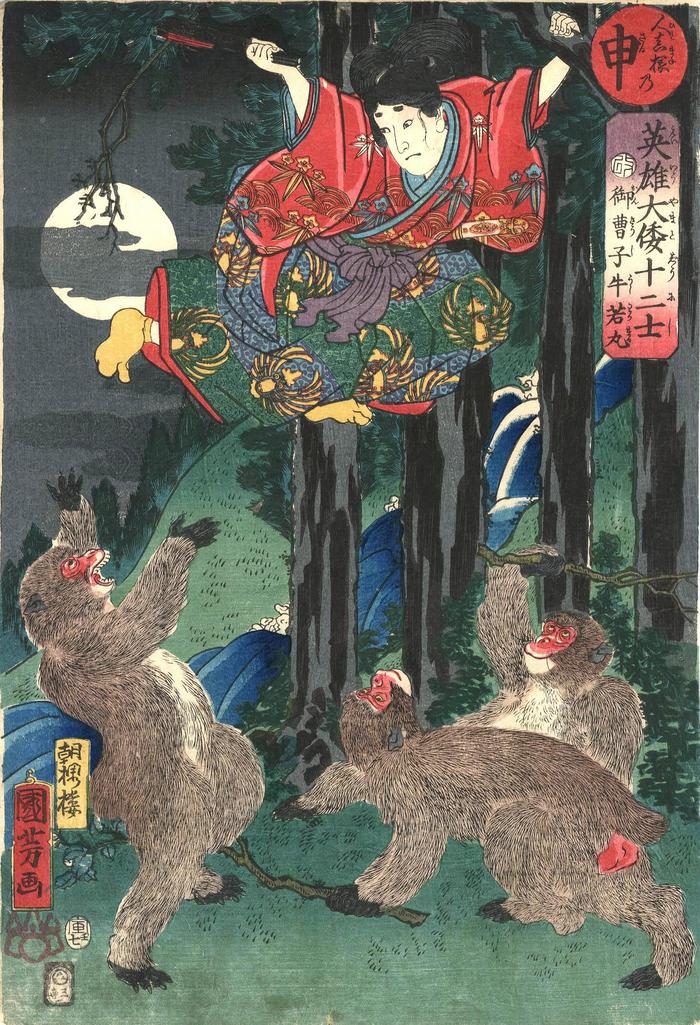Utagawa Kuniyoshi (歌川国芳) (artist 11/15/1797 – 03/05/1861)
Monkey (Saru - 申): The Nobleman's Son Ushiwakamaru (Onzōshi Ushiwakamaru) from the series Japanese Heroes for the Twelve Signs (Eiyū Yamato jūnishi - 英雄大倭十二支)
1854
10 in x 14.5 in (Overall dimensions) color woodblock
Signed: Chōōrō Kuniyoshi ga
朝櫻楼国芳画
Aritist's seal: kiri in red
Publisher: Mikawaya Kihei
(Marks 326 - seal 12-047)
Date seal: 1854, 7th month intercalary (寅壬七)
Censor's seal: aratame
British Museum
Lyon Collection - another print from this series: the Hare (U)
British Museum - Ram/Goat (Usuji)
British Museum - Rat (Ne)
British Museum - Dog (Inu)
British Museum - Boar (I)
British Museum - Horse (Uma)
British Museum - Tiger (Tora)
British Museum - Tori (Cock)
British Museum - Mi (Snake)
British Museum - Tatsu (Dragon)
British Museum - Ushi (Ox) This series lines up with the signs of the Zodiac, however, only a couple of them show their creatures explicitly, like the one here in the Lyon Collection. The one for inu (dog) is another example as is the u (hare) helmet worn by Shinozuka Iga no Kami.
When Ushiwakamaru grew up his name was changed to Minamoto Yoshitsune. On the red upper robe of this young warrior is the family crest, the sasarindō. Mark Griffiths in his The Lotus Quest: In Search of the Sacred Flower on page 245 wrote: "The personal, rather than clan mon of Minamoto no Yoritomo was the sasarindō, a design in which three flowers of rindō (the Japanese gentian, Gentiana scabra or G. makinoi) sit above three leaves of the shrubby bamboo Sasa. The gentian was characteristic of the damp grassland flora of Southern Japan, while the bamboo was a signature plant of the North. This elegant posy is iconographic code for the shogun: the North is subjugated by the South; the country united under his military authority."
****
Ushiwakamaru is practicing his martial skills which he learned from the tengu on Mt. Kuruma. Leaping high in the air, out of reach of the belligerent simians, Ushiwakamaru grasps a tree limb with his left hand while brandishing his closed fan in his right.
Note how the monkeys are using tree branches as weapons of their own. This reminds us of that seminal moment is Stanley Kubrick's 2001: A Space Odyssey when one of our primordial ancestors discovered tools/weapons.
Reference: B. W. Robinson, Kuniyoshi-The Warrior Prints, London, 1982, no. S84.
Even though the British Museum says that the publisher is Mitaya Kihachi, the mark on their copy is that of Mikawaya Kihei.
****
The heroes along with their accompanying signs are listed below:
- Kusunoki Masashige - Utsuji (Ram
- Shirafuji Hikoshichiro - Uma (Horse)
- Shinozuka Iga-no-kami - U (Hare)
- Kato Kiyomasa - Tora (Tiger)
- Kumasaka Chohan - Ne (Rat)
- Kajiwara Heizo Kagetoki - I (Boar)
- Hata Rokurozaemon - Inu (Dog)
- Sasaki Sabura Moritsuna - Tori (Rooster)
- Onzoshi Ushiwaka-maru - Saru (Monkey)
- Egara Hata - Mi (Snake)
- Musashibo Benkei - Tatsu (Dragon)
- Yamamoto Kansuke Nyudo Doki - Ushi (Ox)
warrior prints (musha-e - 武者絵) (genre)
Mikawaya Kihei (三河屋喜兵衛) (publisher)
mitate-e (見立て絵) (genre)
Minamoto no Yoshitsune (源義経) (role)
